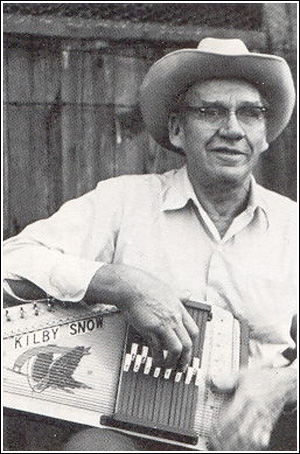Kilby Snow (FRC205)
by Joe Riggs
Much has been written about the life and music of Kilby Snow, an autoharp player of the old tradition of playing below the chord bars. Most folks who know his music and style think first of his famous “drag notes,” a technique he developed to simulate a guitar slide or run on the autoharp, caused when he drags the pick upward from lower strings to higher strings. The first 2-3 strings are picked with no chord bar depressed, then a bar is pushed down, with 4-5 strings total sounding singly in quick succession, and ending on the target note appropriate to the line of music in which the drag notes occur. The placement of drag notes is a critical factor in a given piece of music, and they affect the timing of the musical phrasing, so they are best done while playing solo or with someone experienced and accustomed to them. They are the usual signature, defining elements associated with Kilby’s music.
However, there are some other, neglected, characteristics of Snow’s playing that deserve attention in the study of his playing style. These are (1) the “double clutch,” (2) picking melody notes on the harp to stay with the notes of the vocal, (3) picking melody notes alternately with both thumb and index finger, and (4) keeping the picking hand moving at all times.
The double clutch is depressing a chord bar twice in this way for two consecutive and identical notes in rapid succession: (1) Push down the bar; (2) Pick the string; (3) Release the bar; (4) Push the bar down again, immediately; (5) Pick the second note; (6) Release the bar.
The second of these four techniques is keeping the notes on the harp with the notes in the vocals. Snow plays the same melody notes on the harp that he is singing in order to accompany himself during vocals, as opposed to chording only.
Third, to catch several notes in rapid succession, Snow would often rotate his wrist as one might do in guitar strumming, catching the correct string in the downward rotation with his thumb, then the next correct string in the upward rotation with his index finger; he used only these two fingers in his harp playing. In essence, he picks lead alternately with thumb and index finger.
The last of these distinguishing characteristics is the most important; he keeps his picking hand moving at all times to accompany his melody picking with rhythm pinches in lower strings (dips). Between lines, between phrases, he dips into the lower strings and pinches with thumb and index finger, sometimes once, sometimes twice, or even three or four lightning fast pinches, to provide the foundation notes for the melody. These dips into lower strings are not always into the bass octave. If the melody line before the dips is in the upper octave, the dips and pinches will most likely be down only into the middle octave. In a study of five songs and tunes by Kilby Snow which contain both drag notes and dips, dips outnumber drag notes every time, usually by 3-4 times as many in a frequency comparison. These foundation dips are what give rise to the expression that he “accompanies himself” on the harp.
These five techniques are the basis of the distinctive style of autoharpist Kilby Snow. He picked with his left hand, on a right-handed harp, below the chord bars. He liked to play with the harp sitting flat on a table, or if sitting, he would place the harp on its longer edge on his lap, with the back of the harp against his torso, the fine strings on top, and the big end to his left. A right-handed picker could achieve the same relative configuration by using a left-handed harp with the bars noved up away from the bridge so as to have some picking room. He reconfigured one of his harps to play in six keys (I, IV, V each), E, F, C, G, D, and A, and it had no minor chords on it. It is believed that he later eliminated two keys and settled for four keys. His son, Jim Snow, continues the Snow playing tradition with a four-key harp, his authentic drag note sound, and a different, distinct pattern of accompaniment. Still using only thumb and index finger, Jim pinches bass with thumb, alternating higher notes with his index finger, picking right-handed on a right-handed harp, below the chord bars. The effect is a smooth, melodious, warble, and it is very pleasing to listen to. This warble is an application of the principle of keeping the picking hand moving. He also incorporates all the other characteristics found in his Dad’s music. Jim is not the only contemporary player to be influenced by Kilby Snow; among the fifty or so players featured on the three-CD set of Autoharp Legacy, at least five of them state in their personal descriptions that they were influenced by his music.
Let us hope that the music of Kilby Snow continues to be played, discussed and emulated, for by attempting to imitate his inimitable style, a player cannot help but develop his or her own distinctive style, incorporating some or all of the characteristics of the original style. With each new piece of his recorded music, the careful listener can discern a new twist, a new note, a new handling of the song or tune. All the autoharpists who know Snow’s music will certainly be grateful to Ray Alden for this latest recording featuring Kilby Snow, as we old aficionados are grateful to Mike Seeger for the first recordings of Kilby, and some of those who don’t know his music yet may discover it, as I did twenty-five years ago, and change their approach to autoharp music forever.

